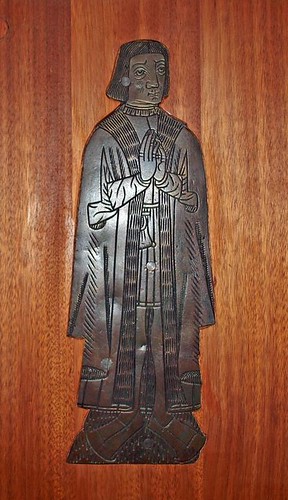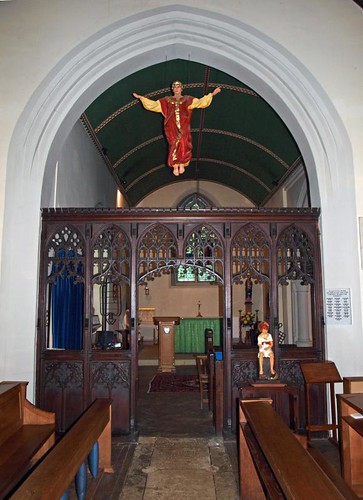Just as I started recording the interior an organist appeared and started playing - I think he regarded me with suspicion and annoyance but I rather enjoyed being serenaded as I wandered around.
It's obviously a very High church - see the Stations of the Cross and the Pieta in the north chapel - and has a rather odd N aisle rood screen figure of the Assumption of Christ, which I'm sure was modelled on Action Man, and an odd seated child Christ but is overall disappointing.
Having said that the brasses in the south aisle (in Pevsner's day in the north) are interesting in their own right; so overall not hugely interesting due to Victorian interference but brownie points for being open.
ST LAURENCE. A remarkable C13 W tower, four-square and sturdy, with clasping buttresses only at the foot. Short spire. Inside, the first floor is carried on two massive posts standing against the rniddles of the N and S sides and a big beam. Arched braces connect posts and beam. Braces on corbels carry the beams along the W and E walls. A fine piece of C13 construction. The rest of the church is mostly of 1862 (by W. G. Bartlett) and undistinguished. The Victorian work may well make one overlook the early C14 N arcade (short quatrefoil piers, moulded capitals, double-chamfered arches). - SCREEN to N chancel chapel. Incorporating C15 fragments. - STALL. (N chapel) with moulded rail and one poppy-head. - FONT. C15; octagonal bowl with quatrefoil panelling. - PLATE. Cup probably of 1608; Almsdish of 1686 ; Paten on foot of 1704. - MONUMENTS. Several brasses in the N aisle, e.g. Elizabeth Dencourt d. 1455, Man in civil dress of c. 1530, Nicholas Wayte d. 1542 and wife, etc. - Andrew Branfill d. 1709, monument with demi-figure on top. - James Esdaile d. 1812, very plain, no figures; by Sir Richard Westmacott.
UPMINSTER. Its fine windmill greets us as we come; if we like to climb to the top of it we can see a sweep of 40 miles of Essex and the hills of Kent. The old-world village has grown into a garden suburb of London; its gabled Elizabethan hall has become the home of a Golf Club; but it keeps one of the most charming 15th century houses in Essex, Great Tomkyns, with lovely windows and projecting wings and a hall open to the roof. By it is a 17th century thatched barn with three bays. Two avenues of yews which have been growing in three centuries bring us to the church with a 13th century nave, a 14th century arcade, and 15th century beams in its tower. The door to the turret stairs hangs on hinges 700 years old, and has been opening and shutting 500 years. There are fragments of woodwork of the same age in one of the medieval screens.
The church has an interesting collection of brass and glass, six brasses having portraits of Tudor and Stuart times. An unknown man in civilian dress is of Henry the Eighth’s day, and Elizabeth Dencourt has a horned headdress and heraldic mantle of the century before. Nicholas Wayte and his wife are on a stolen medieval brass which has an abbot on the back, and above them is a brass of a lady of 1560 with a book in her hand. Dressed in elaborate armour is Geerardt d’Ewes with his feet on what looks like a wolf, and in a beautiful dress with a wide collar is Grace Latham of 1626.
St George appears twice in the chancel, once in a modern statue and again in the east window in memory of one of our heroes. Another chancel window has Our Lord and eight saints, one of them holding a model of the oldest church in Essex. In a smaller window is a medley of old and. new glass, with the year 1630 standing out from heraldic devices and little butterflies giving it charm. We noticed in it the figure of a child in swaddling clothes.
A sword hanging on the wall belonged to one of the sailors of the Holden family who have long been distinguished in Upminster. They have been rectors since 1780, one of them for 63 years. Here is the grave of Dr Henry Holden who died at 95 after being Headmaster of Uppingham, and by it is the tomb of Luther Holden who died at 90, having been President of the Royal College of Surgeons.
The church has an interesting collection of brass and glass, six brasses having portraits of Tudor and Stuart times. An unknown man in civilian dress is of Henry the Eighth’s day, and Elizabeth Dencourt has a horned headdress and heraldic mantle of the century before. Nicholas Wayte and his wife are on a stolen medieval brass which has an abbot on the back, and above them is a brass of a lady of 1560 with a book in her hand. Dressed in elaborate armour is Geerardt d’Ewes with his feet on what looks like a wolf, and in a beautiful dress with a wide collar is Grace Latham of 1626.
St George appears twice in the chancel, once in a modern statue and again in the east window in memory of one of our heroes. Another chancel window has Our Lord and eight saints, one of them holding a model of the oldest church in Essex. In a smaller window is a medley of old and. new glass, with the year 1630 standing out from heraldic devices and little butterflies giving it charm. We noticed in it the figure of a child in swaddling clothes.
A sword hanging on the wall belonged to one of the sailors of the Holden family who have long been distinguished in Upminster. They have been rectors since 1780, one of them for 63 years. Here is the grave of Dr Henry Holden who died at 95 after being Headmaster of Uppingham, and by it is the tomb of Luther Holden who died at 90, having been President of the Royal College of Surgeons.



No comments:
Post a Comment